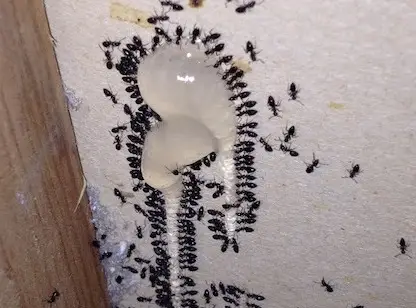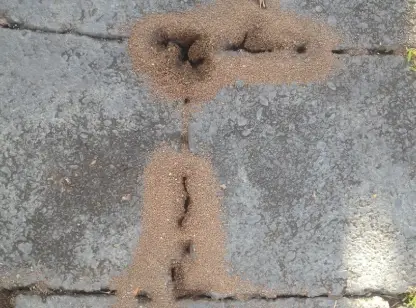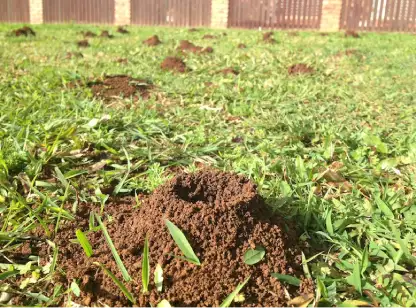![]()
Professional Ant Exterminator – Hills District and Western Sydney
Professional ant exterminator services are really the only way to get rid of ants and prevent them coming back.
To get lasting pest control for ants it’s important to kill the entire nest, which needs expert knowledge on ant identification, knowledge of their behaviours and professional ant control products (supermarket products just don’t cut it!).
For complete and safe ant treatments call the experts at Serial Pest Control
Professional Ant Control – How we get rid of ants…
Our general pest control treatment will help to keep ants out of the house, but if you have an ant problem it’s necessary to carry out a specialist ant treatment to eliminate the nest causing the problem.
The types of ant treatments we carry out depends on the type of ant causing problem and its location: indoors, outdoors or in the lawn.

Ant gel

Ants in pavers

Funnel ant nest
Indoor ant treatments
Our choice indoor ant treatment depends on whether the ants are actually nesting inside (they quite often nest wall cavities and roof voids), or whether they are coming in from outside.
For ants nesting inside, we will often use ant baits as the main control product. We often use ant gel baits as these are favoured by the several black house ant species.
For ants coming in from outside we will often use a combination of baits inside and sprays around the entry point outside and along their foraging trails.
Outdoor ant treatments
Our outdoor ant treatments mainly utilise specialised non-repellent sprays. It is important that they are non-repellent as it allows the ants to walk on the treated surfaces and pick up the insecticide on their bodies. As they interact with their nest mates they pass on the insecticide, magnifying its impact. If enough of the ants are affected the colony dies.
To stop ants entering the building, we carry out a perimeter spray creating a treated band 1m up the wall and 1m out from the wall, as well as around doors, windows and other potential entry points. It is important that we also treat all other areas where ants are active – their foraging trails, in between pavers and their nests (if they can be located).
Lawn ant treatments
For ants in the lawn, we will do targeted sprays and bait treatments to nests and areas of activity. The key pests in sydney lawns are funnel ants, which make their unsightly mounds of soil and green-head ants, which can deliver a painful bite.
How ant baits work…
Ant baits are made up of an attractive food material and slow acting insecticide. Foraging ants take the bait back to the nest where it is fed to their nest mates, including the larvae and queen, eliminating the nest. The insecticide is designed to be slow acting so it can be taken back to the nest and spread around the colony before the ants realise something is wrong.
Of course, not all ants like the same food and so there are a range of baits available. With the different ant species preferring different foods, when using ant baits, the trick is to choose the right bait for the species of ant present and to ensure enough bait is used to eliminate the nest. That’s where the expertise of Serial Pest Control kicks in! We have access to a range of professional ant baits.
What to expect from our ant treatments?
If we can treat the nest directly, you should have instant relief from your ant problem. More often if we are using baits, it will normally take 1-3 weeks to get control, but can take 1-2 weeks for large nests. Sometimes for large infestations a second visit may be required.
There are some ants species, such as the coastal brown ant (or big-headed ant), that infest large areas, with multiple nests. With such ant species, it is never possible to get complete control as the ants re-invade from surrounding areas. Our treatment will provide relief for several months, but regular re-treatments will be necessary to keep the problem under control.
Types of ant in Sydney
The most common 5 types of ant we find in Sydney are the the black house ant and white footed ant which are mainly indoor ants, the coast brown ant which is an outdoor ant but will come inside, and the green-head ant and funnel ant, which are lawn ants.
Black house ant
The black house ant is one of the most common indoor ants in Sydney. They aren’t a dangerous ant, just very annoying! They tend to like sugary foods. They are relatively easy to control in that they only build a single nest, so once the nest has been destroyed, the problem is eliminated. They often build their nests indoors in wall voids and roof voids, which means they can sometimes be tricky to locate. However, by using baits we can eliminate the nest, without knowing exactly where it is.

White footed ant
White footed ants or the white footed house ant, look very similar to black house ants. However, it is important to be able to tell the difference, as they have a very different nest structure and so require a different control method. White footed ants develop colonies containing several nests containing a large number of reproductives, which means they can produce a large number of eggs and so the infestation can get out of hand quickly. To gain control all these reproductives need to be killed. It will often be necessary to use a combination of baits and sprays to get control.
Coastal brown ant
The coastal brown ant is an invasive ant (from South America) and can dominate outdoor areas. Although it doesn’t bite or sting humans, due to their sheer numbers, they out-compete other ants in the area and also attack native wildlife. They build their nests underground and often under paths and pavers, digging up the dirt. Granular baits can be very effective in eliminating the nests, but sometimes we also use sprays. However, as the coastal brown ants can develop “super-colonies”, ant can re-invade an area over time.

Green-head ant
The green-head ant is found in lawns and garden beds throughout Sydney. It is an aggressive ant with a painful sting, which can itch for days afterwards. Often there will be several nests in the yard. Green-head ants are relatively easy to control as they produce discrete nests which can be treated with bait or spray.

Funnel ant
Funnel ants are not often seen, but their mud funnels are very obvious making a mess of the lawn. These funnels are the result of them digging dirt up from underground to build their nests. Not only do their make the lawn unattractive, they can cause subsidence, with the uneven lawn causing injuries and damaging equipment. A funnel ant infestation can devalue a home. Successful elimination and long lasting protection from funnel ants can be achieved by treating the whole lawn with a specialist ant spray.


Early signs of an ant infestation?
If you have ants invading your home or you can see large numbers of ants outside, you obviously know you have a problem. However, there are three other signs that can tell you there are ants nesting nearby and they may soon become a problem.
Dirt being dug up in the lawn and between pavers
Ant nests can be difficult to spot but when they dig their nest in the lawn or under pavers, the dirt they excavate becomes visible. The ants may not be a problem immediately, but you want to stop the ants at the nest building phase as this activity can damage pavers and lawns, devaluing your home!
Ant rubbish piles
Ants keep their nests very clean and regularly thrown out waste material and dead nest mates. If they have built their nests inside the wall cavity or roof void, they will often deposit this rubbish outside the nest – often through a hole in the wall or through a downlight. So, if you see piles of dirt and dead ants on the floor, you could have an ant nest nearby.
Flying ants
During the warmer months, flying ants emerge from their nests on their mating flights. These are the new kings and queens emerge in great numbers to fly off, find a mate and start a new nest. If you find lots of flying ants around your house you will have a large ant nearby. These flying ants can often be confused with flying termites, and a nearby termite nest is a significant threat to your home. So, if you spot some flying insects and not sure what they are, give Serial Pest Control a call.
What our customer say…
How to prevent ants invading your home?
Ants sometimes come inside to escape periods of hot or very wet weather, but more often they come inside looking for food or moisture.
By removing sources of food and moisture you will make your home less attractive to ants:
- Clear up spilled food
- Don’t leave pet food bowls out (especially with food in)
- Don’t leave unwashed dishes on the side after meals
- Make sure food is stored in tight fitting, “ant proof” containers
- Rubbish should be put in sealed bags before placing in the bin
- Fix any leaking taps or pipework
Filling any cracks around windows, doors and utility pipes to prevent ants entering the building.
Other pest control services from Serial Pest Control.
For complete and safe ant treatments call the experts at Serial Pest Control

